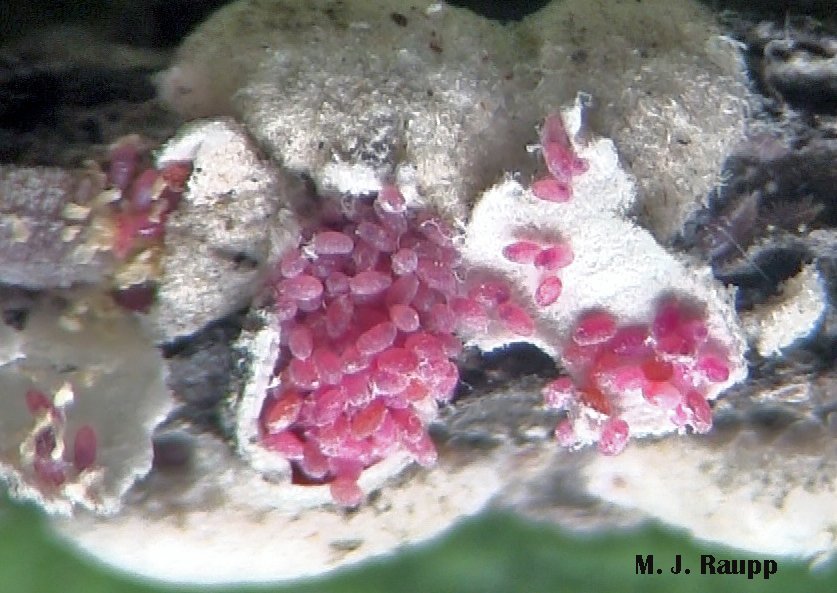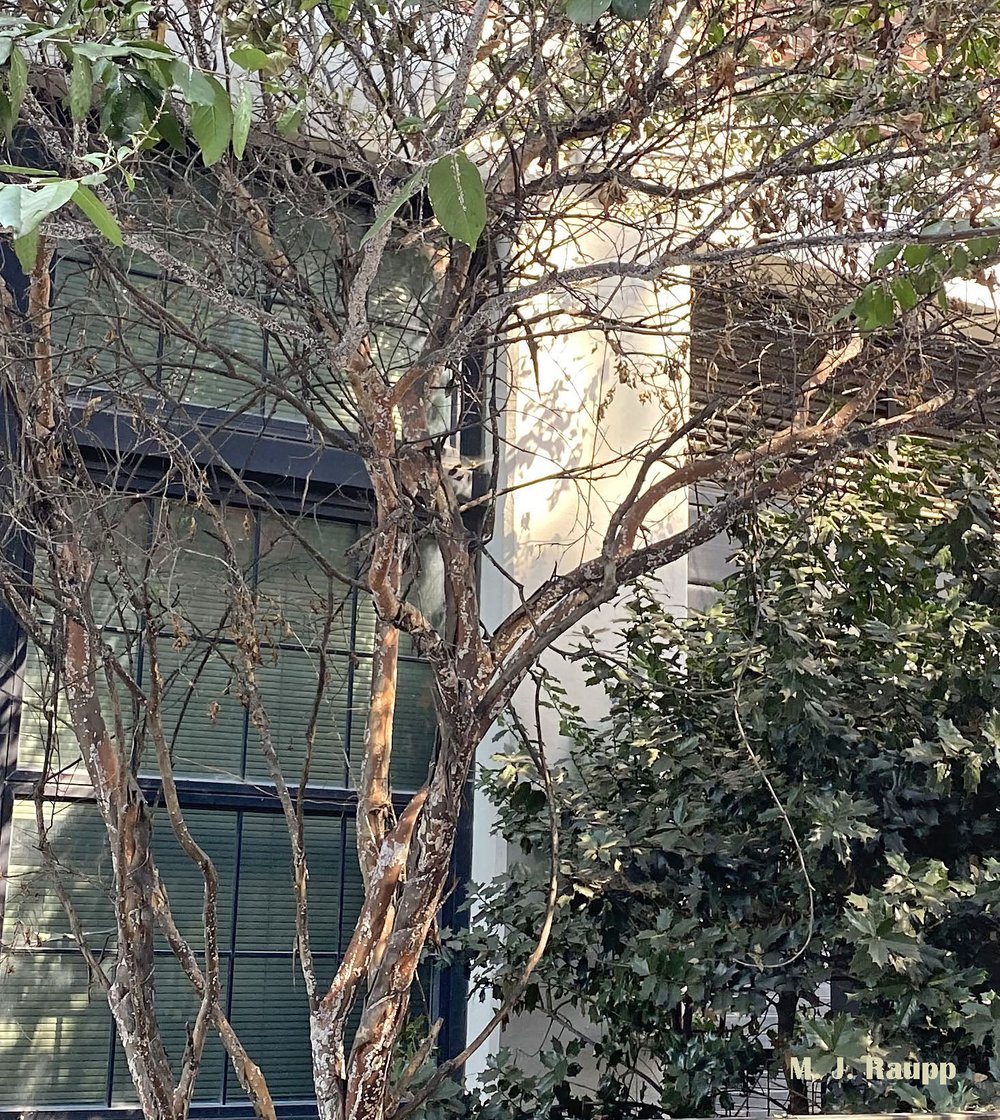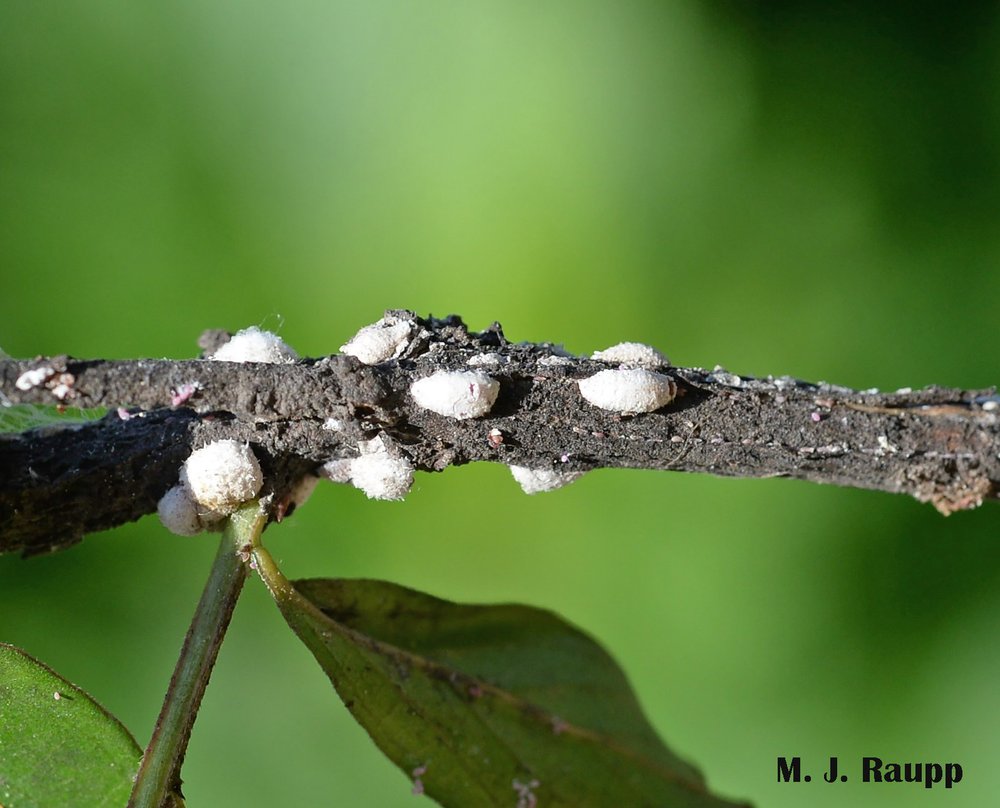Crapemyrtles are not dreaming of a white Christmas: Crapemyrtle bark scale, Acanthococcus (=Eriococcus) lagerstroemiae

What lies beneath the snowy white egg-sac of crepe myrtle bark scale? Hundreds of pink eggs!

That’s not snow on the branches of this crapemyrtle. Thousands of crapemyrtle bark scales suck sap, killing limbs and excreting honeydew which supports the growth of black sooty mold.
On recent visits to the thriving metropolis of Washington, DC, we met dastardly soft scales and rambunctious red-shouldered bugs enjoying meals served-up by oak trees and golden rain trees lining the avenues of our nation’s capital. This week we return to DC to visit glorious crapemyrtle trees and scandalous scale insects intent on turning crapemyrtle branches snowy white. Originally native to Asia, crapemyrtles traveled with botanical explorers from their aboriginal homes to gardens in Europe and the Americas more than 250 years ago. As North America warms, the range of crapemyrtles has expanded from subtropical southern states to mid-Atlantic locations, including Maryland and DC where milder winters and hot summers allow them to thrive. But, as is often the case with non-native plants, sometime after their arrival in a new land, their pests from afar soon follow them to the invaded realm. This was the case for crapemyrtles, when in 2004 the crapemyrtle bark scale, a type of felt scale, was discovered in Richardson, TX. Since the first detection in 2004 it has marched steadily northward to North Carolina in 2016, to Virginia in 2017, and to Maryland in 2020. Range expansion of this and many other scale insects happens in a variety of ways. Infested nursery stock shipped from southern states may convey scales to new locations. Some scale insects climb onto the feet of birds, hair of mammals, and bodies of flying insects and become unwittingly transported by these other animals from an infested to an uninfested tree. In an even stranger twist, some scale insects actually utilize “takeoff” behavior to help them become airborne and then ride the wind from one plant to another. Insects as aeronauts, how cool is that!
Monocultural plantings of crapemyrtles and other street trees often support outbreaks of pests in cities. Beneath the snowy white egg-sac, we find a bizarre female crapemyrtle bark scale. She can lay more than 300 bright pink eggs. Eggs hatch into pink crawlers that sally forth to settle new patches of bark. They molt before producing their own egg-sac. Heavy infestations kill branches and foul the bark with honeydew, which supports the growth of ugly sooty mold fungus.
Like the aforementioned soft scale, crapemyrtle bark scale feeds on nutrient-rich plant sap called phloem. To gain sufficient nutrients for growth, development, and reproduction, vast quantities of phloem are imbibed. Once processed, any remaining liquid is excreted in the form of a sugary waste product called honeydew. Honeydew rains down from infested plants onto vegetation, sidewalks, vehicles, and furniture below, creating a sticky mess that also attracts stinging insects like paper wasps, yellow jackets, and honeybees. Adding insult to injury, honeydew serves as a substrate for the growth of a nasty black fungus called sooty mold which discolors bark, leaves, and other objects on which it lands. Removal of vital plant sap and damage caused by thousands of piercing mouthparts can result in branch dieback and death of crapemyrtles.

A close-up reveals egg-sacs of females and encrustations of black sooty mold covering a branch.
Life gets busy for crapemyrtle bark scales when tiny pink nymphs hatch from tiny pink eggs laid by the female in her snowy white, felt-like egg-sac (a.k.a ovisac) which encloses the she-scale and her young. These nymphs go by the name of crawlers and that’s exactly what they do, crawl to new parts of the crapemyrtle and settle down to suck sap from their crapemyrtle host. Each female can lay from 100 to more than 300 eggs. In warm regions there may be four generations annually and it is easy to see how populations can explode seemingly overnight. While crapemyrtles are the primary target for this rascal here in the US, this scale has also been found on more than a dozen other plant species in the US and other parts of the world, including beauty berry, pomegranate, boxwood, persimmon, privet, brambles, and many others.

Predators like this lady beetle eat scale insect, including crapemyrtle bark scale.
So, is there any good news here? You bet. Several members of Mother Nature’s hit squad, including lady beetles, lacewings, and parasitic wasps are known to attack and kill this felt scale. However, in many cases once the scale gets rolling even these beneficial insects may not be enough to put a beat-down on this pest. Many potent insecticides are available to kill both immature and adult stages of the scale. Here in the DMV an outstanding corps of certified arborists is available to help homeowners and urban foresters manage this invader. Let’s hope that all crapemyrtle Christmases aren’t white.
Acknowledgements
“Biology and Management of the Crapemyrtle Bark Scale: Landscape and Nursery Grower” by Erfan Vafaire, Mike Merchant, and Mengmeng Gu, “Crawler behaviour and dispersal” by David J. Greathead, and “Phoretic dispersal of armored scale crawlers (Hemiptera: Diaspididae)” by J. Magsig-Castillo, J. G. Morse, G. P. Walker, J. L. Bi, P. F. Rugman-Jones, and R. Stouthamer were used to prepare this episode.
This post appeared first on Bug of the Week